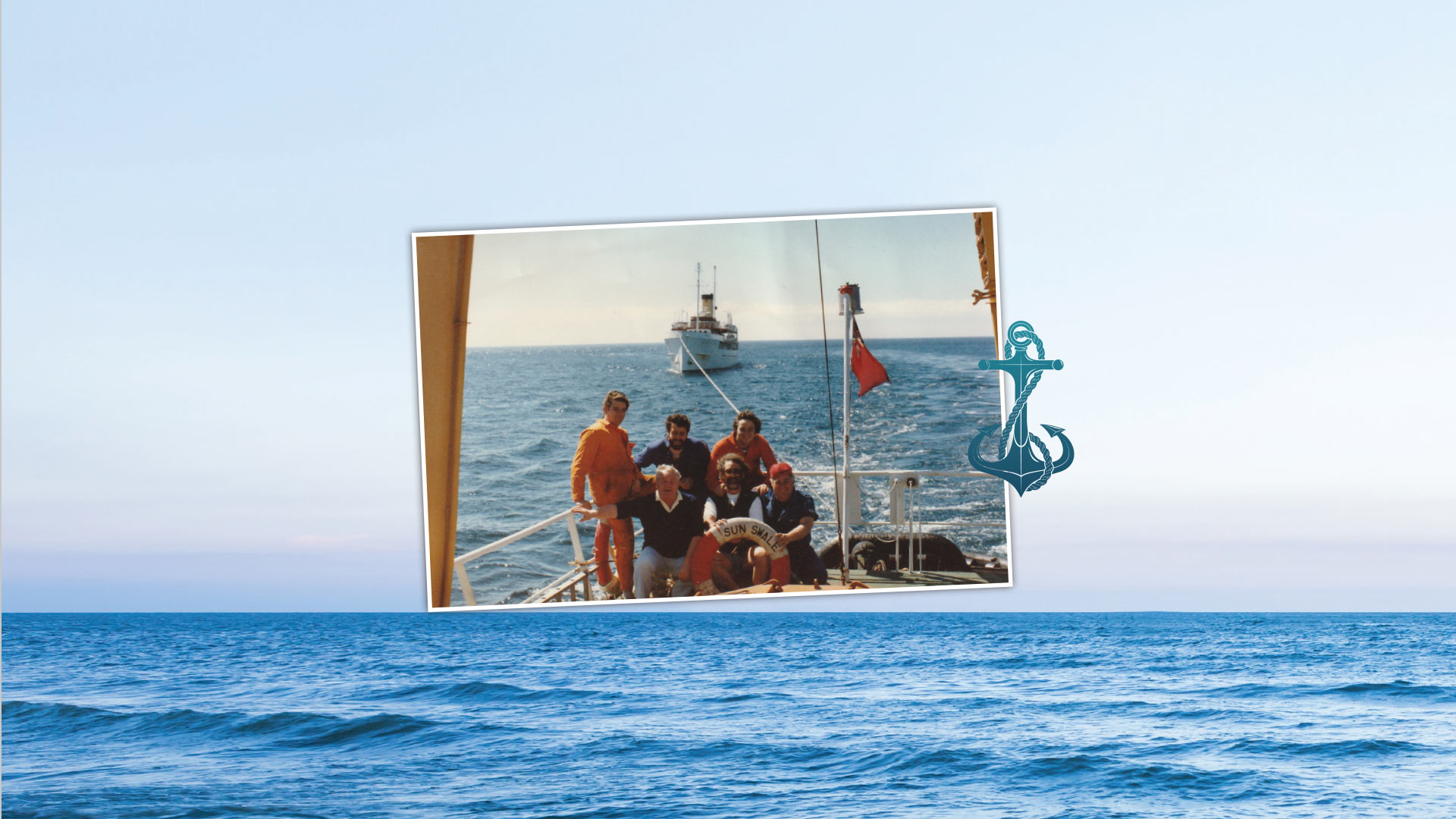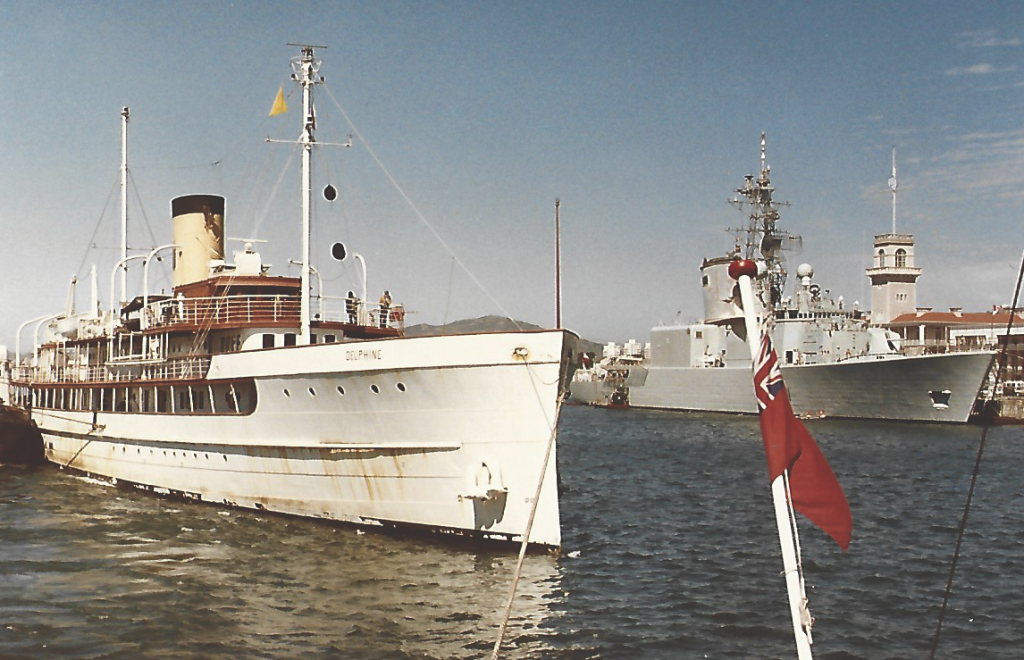At the age of sixteen Robin Batchelor was sent to sea by his mother, the beginning of a long career on the water that elicited many different adventures. “I started as a deck boy in the Merchant Navy and apart from the ship’s cat you can’t get any lower than that,” Robin tells me.
There are so many stories to relate, but one that has stuck in Robin’s mind was during his first voyage on the SS Oriana that took him into the Red Sea, through the Suez Canal. “Having read odd biblical pieces at school as a youth, I wasn’t massively surprised when the Deck Man said we had a busy morning ahead because we had just been hit by a swarm of locusts,” Robin says. What he hadn’t expected was to find a swarm at least half a foot deep on the boat deck. “As we swept them they went from pale yellow to dark orange and half of them would jump back over the broom.” Taking this incident for granted, Robin says he assumed this sort of thing happened every trip but comments that he never saw a locust ever again.
“I then got an apprenticeship with Common Bros. of Newcastle to become a Deck Officer and went on a mixture of iron ore carriers and tankers,” Robin explains. “However, I had to get everybody to write things down for me because I couldn’t understand Geordie at all!”
Acquiring his Second Mates certificate, Robin went back to sea, firstly on giant super tankers then on to refrigerated cargo ships before he became First Mate. It was when he was working with Shaw Savill that Robin found out that the Chief Officer on the Mons Calpe, the passenger and car ferry operated by the Bland Line between Gibraltar and Tangier, was retiring and he applied and got the job.
“I joined the Mons Calpe in 1969 and worked on it for fourteen years,” Robin states. “In 1984, married and with two little girls, I didn’t want to go back to deep sea work, so I became a foreman for the BP petrol stations, the main one being at Waterport,” Robin clarifies.
During that period there was a little Norwegian owned high speed catamaran that ran from M’Diq to Gibraltar. “They couldn’t get a Chief Officer at the time and my certificates were still in order,” Robin states. “They borrowed me for a weekend, and then the weekend turned into two weeks and they got me a Norwegian dispensation for my British certificates.” In typical Robin Batchelor fashion, one day his boss at BP asked why he would come rushing in so late on a Wednesday. “The truth was that I didn’t get back from M’Diq until one o’clock, so I used to grab all the paperwork from BP on a Tuesday and take it with me and do it on the way across or the way back – so I managed to do two full time jobs for a period of four months which was good fun but very tiring.”
Talking about ‘borrowing’, Robin was borrowed by Lionel Ferro from the Alexandra Towing Co. to act as a navigator on their tugs. “This was because I had a Navigator Certificate and without me the tugs couldn’t go outside Europa Point.” Robin says that Lionel used to look out for any ships that needed salvaging. “Over the years I helped him with several salvage jobs, and luckily on the final one that I did for him I remembered to take my camera.”
Robin’s last salvage job in 1986 was for the SS Delphine, a large steam yacht that had broken down North West of Tangier out in the Atlantic. “Once Lionel had been notified by Windmill Hill that a yacht had broken down, he set in motion to try and find me and I had to ask my boss if I could go away for a day, maybe two, to try and locate this yacht,” Robin says. “This was in the days before AIS (automatic identification system) and in those days everything was done via VHF (very high frequency).”
As it turns out, the steam yacht was very easy to find by the crew of the Sun Swale tug (sunk in 2015 off the South Mole to create an artificial reef) who managed to get a line aboard. “She was an absolute pig to tow and yawed about all over the place and Windmill Hill issued a “Notices to Mariners” warning shipping to give us a wide berth, repeated hourly on V.H.F.”
The owners of the steam yacht had signed the Lloyd’s Open Form, a salvage contract very rarely used these days, which states that in return for salvage services the salver receives a proportion of the salved value (the value of the ship, its cargo and bunkers). “The captain gets a big share, the officers a smaller share and the crew an even smaller share of the salvage money,” Robin explains.
“We managed to bring her back in and turned her round in the harbour before she was put alongside the South Mole where she stayed for quite a long time.”
Once she was alongside in Gibraltar, Robin with camera in hand, went aboard. “This is how the inside looked at the time, including the engine room with its Steam Reciprocating engine,” he explains. “That was part of the problem, because when the ship had been reconditioned in the USA, they thought they had done a good enough job with the steam tubes to get her across the Atlantic, but they didn’t and that is why she ended up breaking down just before entering the Strait of Gibraltar.”
Launched in 1921, the SS Delphine is a 78-metre Great Lakes Engineering Works yacht built by Horace Dodge of the Dodge automobile empire, who unfortunately died before she was completed. She is the largest steam yacht built in the USA and Horace Dodge himself designed her unique quadruple-expansion steam engines. In 1926 a fire sent her to the bottom of the Hudson River, resulting in her first salvage.
During World War II in the 1940s, the yacht was requisitioned by the navy, renamed USS Dauntless, and served her country as flagship to the US Navy’s top admiral, before being sold back to Anna Dodge (Horace Dodge’s wife) and restored to civilian standards and service, including her original name. Legend has it that she was the yacht where Churchill, Truman and Stalin prepared the Yalta convention.
The yacht then had a chequered history, changing hands in 1967 and again in 1968, which also resulted in another name change back to Dauntless, only to be sold again in 1986 and 1989. In 1997 the Delphine underwent a five year restoration in Belgium by her then owner, a Belgian businessman who invested 45 million euros to bring SS Delphine back to her original configuration of 1921, restoring her to her former glory and recreating the bygone era of the roaring 20’s. Today she is the last operational steam-powered superyacht afloat. In 2003 she was rechristened SS DELPHINE by Princess Stéphanie of Monaco before being sold to her current owner in 2015 and Monaco is where she is now available for charter in the Mediterranean at an eye watering weekly rate of around 400,000 euros.
Now at the age of 76 Robin is still a very busy man and a well-known face in Gibraltar where he keeps an interest in two businesses: the Cycle Centre and Marine & Industrial Services trading as The Battery People. There are so many amusing and interesting stories to be told about Robin’s life that can’t be included here, especially the humorous incidents that he can recount during his time on the Mons Calpe, so we look forward to featuring Robin again in the near future.










